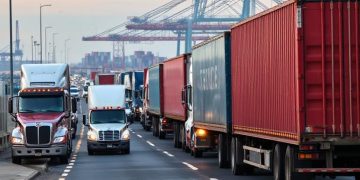The San Pedro Bay port complex — consisting of the Port of Los Angeles and the Port of Long Beach — has long been a critical driver of the U.S. economy and the busiest seaport in the western hemisphere. However, activity at the ports has recently slowed following new tariffs announced by the Trump administration.
Approximately one-third of traffic at the port has been disrupted, according to Eugene Seroka, chief executive officer of the Port of Los Angeles. The administration’s new policy applies a minimum 10% tariff on a wide range of imported goods, with higher rates targeting products from 57 countries, including China, Vietnam, and Cambodia.
The slowdown is already affecting waterfront communities such as San Pedro, Wilmington, and Long Beach, where over 70% of port workers live. Gary Herrera, president of the International Longshore and Warehouse Union (ILWU) Local 13, emphasized that the economic impact is expected to spread beyond the ports, affecting warehouse hubs like Riverside, San Bernardino, Bakersfield, and Barstow — key centers in the regional and national logistics network.
Diane Middleton, a former Los Angeles harbor commissioner, noted that because the port complex handles about 40% of the United States’ containerized imports, disruptions are likely to have widespread national effects. “Cargo that comes in here reaches all 435 U.S. congressional districts,” Middleton said.
Prior to the implementation of tariffs, retailers had accelerated imports in anticipation of possible trade policy changes. However, experts estimate that the stockpiled goods will sustain operations for only six to eight weeks.
While the administration characterized the tariff action as a strategic effort to promote domestic industry and reduce reliance on foreign imports, workers at the ports report immediate concerns over reduced workloads. Vivian Malauulu, a longshore worker and ILWU Local 13 officer, said vessel arrivals have declined, leading to a reduction in available shifts. Workers who previously had full workweeks are now averaging three to four shifts per week, prompting adjustments in household spending.
The response among union members has been varied. Some workers expressed initial support for policies framed as protecting American industry, while others are now concerned about the broader economic impact. The International Longshoremen’s Association (ILA) on the East Coast also had members who engaged with the administration on trade-related issues.
Herrera stressed the need for solidarity among port workers, noting that while California’s ports may experience immediate effects due to their volume of Asian trade, ports across the country are also at risk. “We are the most resilient workforce in the world,” he said. “During the Covid pandemic, we kept cargo moving. We’re hopeful for a resolution that protects American workers and communities.”
In addition to the tariffs, new rules announced by the Office of the United States Trade Representative (USTR) will phase in fees on ships built in China. Jamieson Greer, head of USTR, stated that the fees aim to reduce Chinese influence over U.S. supply chains and stimulate demand for U.S.-built vessels. These charges, starting at $50 per net ton per voyage and increasing to $140 by 2028, are expected to affect shipping costs significantly. Beijing has indicated it will respond to these measures.
The ports have responded to the changing landscape by tripling the number of projected blank sailings — canceled ship calls — from 10 in April to 30 expected in May.
Despite current challenges, port workers express cautious optimism. “If and when the work comes back, we’ll be here,” Herrera said.
Get top supply chain report news on The Supply Chain Report. For international trade insights and tools, visit ADAMftd.com.
#LosAngelesPorts #PortTraffic #TradeTariffs #ShippingDelays #GlobalTrade #SupplyChainImpact #MaritimeLogistics

















